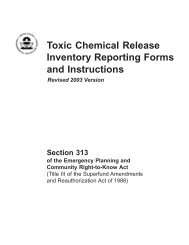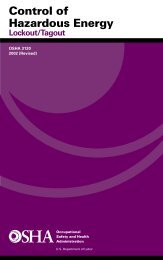Preventing Mold-Related Problems in the Indoor Workplace - Seton ...
Preventing Mold-Related Problems in the Indoor Workplace - Seton ...
Preventing Mold-Related Problems in the Indoor Workplace - Seton ...
Create successful ePaper yourself
Turn your PDF publications into a flip-book with our unique Google optimized e-Paper software.
Build<strong>in</strong>g-<strong>Related</strong> Illnesses<br />
Health effects that can be caused by mold<br />
Most people experience no health effects from exposure to <strong>the</strong><br />
molds present <strong>in</strong> <strong>in</strong>door or outdoor air. However, some <strong>in</strong>dividuals<br />
with underly<strong>in</strong>g health conditions may be more sensitive to molds.<br />
For example, <strong>in</strong>dividuals who have o<strong>the</strong>r allergies or exist<strong>in</strong>g<br />
respiratory conditions such as asthma, s<strong>in</strong>usitis, or o<strong>the</strong>r lung<br />
diseases may be more easily affected. Similarly, persons who have<br />
a weakened immune system tend to be more sensitive to molds.<br />
A person’s immune system can be weakened if <strong>the</strong> <strong>in</strong>dividual has<br />
conditions such as pregnancy, diabetes, autoimmune disease,<br />
leukemia or AIDS; or if <strong>the</strong> <strong>in</strong>dividual is recover<strong>in</strong>g from recent<br />
surgery or receiv<strong>in</strong>g chemo<strong>the</strong>rapy or long-term treatment with<br />
steroids; or if <strong>the</strong> <strong>in</strong>dividual is <strong>the</strong> recipient of a recent organ or<br />
bone marrow transplant. In addition, <strong>in</strong>fants, children, and <strong>the</strong><br />
elderly have been shown to be more susceptible to health problems<br />
attributable to molds (1, 5, 9).<br />
The most common health effects associated with mold exposure<br />
<strong>in</strong>clude allergic reactions similar to common pollen or animal<br />
allergies (5). Symptoms <strong>in</strong>clude sneez<strong>in</strong>g, runny nose, eye irritation,<br />
cough<strong>in</strong>g, congestion, aggravation of asthma, and sk<strong>in</strong> rash (1, 3).<br />
These symptoms are also common reactions to o<strong>the</strong>r agents that<br />
cause allergies, and it is not always possible to s<strong>in</strong>gle out <strong>the</strong><br />
specific cause. More severe health reactions, such as hypersensitivity<br />
pneumonitis, can occur <strong>in</strong> susceptible <strong>in</strong>dividuals.<br />
The three types of adverse health effects <strong>in</strong> humans caused by<br />
mold are allergy, <strong>in</strong>fection, and tox<strong>in</strong>-mediated conditions (12).<br />
Fur<strong>the</strong>r discussion of <strong>the</strong>se health effects is provided <strong>in</strong> Appendix A<br />
of this document.<br />
Preventive Ma<strong>in</strong>tenance<br />
<strong>Prevent<strong>in</strong>g</strong> mold growth <strong>in</strong> occupied areas<br />
The key to mold prevention is moisture control. The most<br />
important <strong>in</strong>itial step <strong>in</strong> prevention is a visual <strong>in</strong>spection. Regular<br />
checks of <strong>the</strong> build<strong>in</strong>g envelope and dra<strong>in</strong>age systems should be<br />
made to assure that <strong>the</strong>y are <strong>in</strong> work<strong>in</strong>g order. Identify and, to <strong>the</strong><br />
9
















